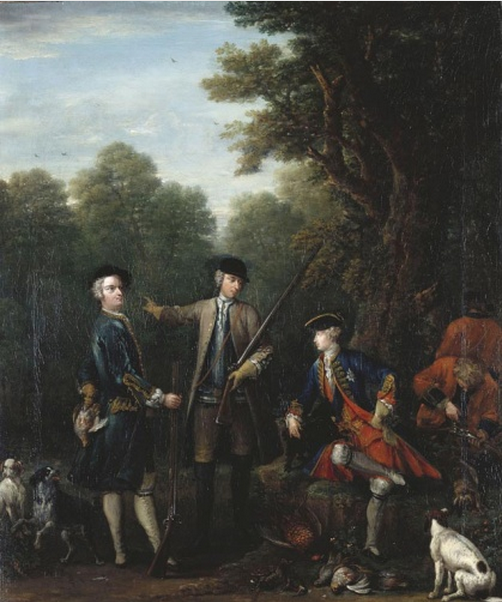|
| |
Charles Douglas, 3rd Duke of Queensberry
(1698-1778),
Charles
Douglas, third duke of Queensberry and second duke of Dover
(1698–1778), courtier and politician, the
son of
James Douglas, second duke of Queensberry and first duke of Dover
(1662–1711), and his wife, Mary Boyle (1670/71–1709), daughter
of Charles, Lord Clifford, was born at Edinburgh on 24 November
1698. Having been created earl of Solway in the Scottish peerage in
1706 in recognition of the services of his father and grandfather,
in 1711 he succeeded his father as third duke of Queensberry (in the
Scottish peerage) and second duke of Dover (British).
After
returning from the grand tour, in 1719 Queensberry unsuccessfully
sought his seat in the House of Lords as duke of Dover, the house
applying its 1712 decision that no peer of Scotland at the time of
the Union could sit by virtue of a British peerage. On 10 March 1720
he married his second cousin Lady Catherine Hyde
(1701–1777), the
second daughter of Henry, second earl of Rochester and later fourth
earl of Clarendon, and Jane, daughter of Sir William Leveson-Gower. Catherine
was a major figure in her own right as a literary patron and
socialite. Queensberry was a successful courtier under George I:
lord of the bedchamber
(1721), vice-admiral of Scotland (1722), and
privy councillor (1726). In 1729 his wife's outrage at the lord
chamberlain's refusal to license the performance of John Gay's
Polly (which satirized Sir Robert
Walpole) led George II to bar her from court and Queensberry to
resign his offices. Thereafter they joined the opposition, the duke
serving as a gentleman of the bedchamber to Frederick, prince of
Wales, from 1733. In 1734 Queensberry took an active part in an
unsuccessful attempt to elect a slate of opposition Scottish
representative peers, standing as a candidate and voting in a peers'
election for the only time in his life.
After the accession of
George III, Queensberry regained his place on the privy council and
became keeper of the great seal of Scotland (1761–3) and lord
justice-general (1763–78). Often solicited by Scots seeking
patronage, the duke was not always able to oblige, as James Boswell
found.
In 1728 Queensberry took up the cause of John Gay when a licence for
his opera Polly was refused.
The Queensberrys lived mostly in England, where they
were prominent in the social life of the capital. The duke
periodically returned to Scotland and remained involved in affairs
there, exercising over his long life the predominant parliamentary
interest in Dumfriesshire and Dumfries burghs. An improving
landlord, he sought to promote Scottish economic development. He was
the chairman of the Firth and Clyde Canal Company and a major backer
of the Ayr Bank (whose failure in 1772 put a dent in the duke's
considerable fortune). He re-built
Durisdeer Church,
including a monument to his parents.
Queensberry's political influence was
probably less than his contemporaries thought, and was likely
limited by his exclusion from parliament. He was regarded as an
amiable and benevolent aristocrat, Boswell characterizing him as ‘a
man of the greatest humanity and gentleness of manners’ and ‘good
plain sense’ (Boswell's London Journal,
63). Many sympathized with the duke and duchess for their fortitude
in the face of sorrow when their adult sons, Henry, Lord Drumlanrig,
and Charles, died within two years of each other in the mid-1750s.
Queensberry died on 22 October 1778 from ‘mortification of the leg
after an accident alighting from a carriage’ (GEC,
Peerage, 10.699), and was buried at
Durisdeer, Dumfriesshire.
He was succeeded in his title and estates
(said to be worth £18,000 p.a.) by the
earl of March and Ruglen, the
son of his first cousin.
 From
a painting in Royal Collection From
a painting in Royal Collection
Friends relaxing during a rough shooting expedition.
John Spencer (1708-46), to the left trying to keep a bird from an eager
spaniel, was the favourite grandson of Sarah, Duchess of Marlborough
(1660-1744), and succeeded her as Ranger of Windsor Great Park a few years later
in 1744. Charles Douglas, 3rd Duke of Queensberry (1698-1778), in the centre
pointing in the direction of the party’s next foray, was Gentleman of the
Bedchamber to the Prince of Wales. Both men wear a jockey cap, an article of
plebeian dress fashionable at the time, and wait upon Frederick, Prince of
Wales, who sits nonchalantly on a bank, stroking a dog and wearing his own
hunting uniform. Two of Frederick’s liveried servants act as loaders behind and
the booty shot so far lies at his feet: hare, pheasant, snipe and kingfisher.
The nearest visual precedent for this sporting elegance can be found in French
scenes of hunters of both sexes resting or eating en plein air, such as Francois
Lemoyne’s Déjeuner de Chasse, 1723 (Alte Pinakothek, Munich). In this comparison
the landscape in Wootton’s image acquires a very different character from
Lemoyne’s: darkening as evening approaches, heavily wooded and suggestive of the
wilder recesses of Windsor Great Park. According to Horace Walpole, Wootton
turned to landscape late in his career, following the style of Gaspar Dughet
(1615-75, then always called Gaspar Poussin), and sometimes, as in the sky here,
imitating ‘happily the glow of Claud Lorrain’ (Anecdotes of Painting in England,
1762).
See also:
Douglas House, Petersham
|


